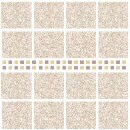Wall Tiles
Wall tiles have held on to their number one position as the covering of choice for most bathroom walls despite the growth in the range of alternative product that are now available.
One of the reasons for the continuing popularity of wall tiles is the extremely wide choice available. Tiles can dramatically affect the look of the room and your choice of tiles will be more important than your choice of bathroom suite or shower cubicle in terms of overall visual impact.
When choosing tiles there are many decisions to be made and these will be influenced by many factors. These factors can narrow down the options which in most cases will aid the decision making process because the sheer volume of wall tiles available can be overwhelming.
The appearance of the tiles will be important to ensure the finished job is acceptable and in-line with your original plans. It could be that you are looking for a natural finish and do not want a man made imitation stone effect tile. Natural stone tiles are very desirable but they can have some practical drawbacks. Many ceramic tiles are designed to replicate the look of natural stone but have fewer limitations on their usage - see our section on natural stone tiles for more details. The difference in price between natural stone wall tiles and ceramic tiles can vary considerably, with some natural tiles being similar in price to ceramic while others are a lot more expensive. Natural stone wall tiles will also require careful fixing and might prove to be too heavy for some types of wall as they tend to be heavier than man made tiles.
As well as there being a wide choice of wall tiles there are also several ways of installing them that can provide different patterns from the same basic tile. The following examples are just a few of the myriad of patterns that can be used for fixing wall tiles.




A basic grid pattern, which is the most common tiling pattern, is broken up in the first diagram by the use of a mosaic border. The second diagram shows the same square tiles laid at 45 degrees to give a diamond effect. This pattern will only work with square tiles and is a little more tricky to install than the standard grid. The herringbone pattern in diagram three is commonly used on floor tiles but can also be used on walls and requires oblong tiles with sides that are in the ratio 2:1 . The fourth diagram shows a modular pattern that requires 4 different tile sizes that are all multiples of the smallest square tile. These sort of repeating patterns can also be a little tricky to install but it does provide a more interesting look than a basic grid. Other patterns include brickwork, basketweave as well as a host of others.


